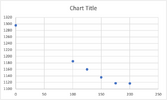JimGnitecki
Member
- Joined
- Mar 28, 2010
- Messages
- 1,258
My buddy told me recently that the range to which the Labradar can track a bullet's velocity varies notably with the size and shape of the bullet. He said that shooting the big fat 485g 45-70 bullet (that I have been trying to find a good handload for and have failed), I MIGHT find that I can track it beyond the 150 yards that I had assumed was the Labradar's limit. He was right.
At yesterday's range session, I extended the requested distancess from a maximum of 150 yards to 175 and 200 yards as well. The Labradar DID provide velocities for both the 175 and 200 yards ranges, although only for about 70% of the rounds fired at 175 yards, and 57% of the rounds fired at 200 yards. But those 70% and 57% velocities looked reasonable and consistent, although the SDs of the velocities were higher at those longer distancess than they were for shorter distances.
So, if you are shooting large bullets, and using a Labradar to track their velocity, your Labradar's working range might surprise you, as it did me.
Jim G
At yesterday's range session, I extended the requested distancess from a maximum of 150 yards to 175 and 200 yards as well. The Labradar DID provide velocities for both the 175 and 200 yards ranges, although only for about 70% of the rounds fired at 175 yards, and 57% of the rounds fired at 200 yards. But those 70% and 57% velocities looked reasonable and consistent, although the SDs of the velocities were higher at those longer distancess than they were for shorter distances.
So, if you are shooting large bullets, and using a Labradar to track their velocity, your Labradar's working range might surprise you, as it did me.
Jim G


